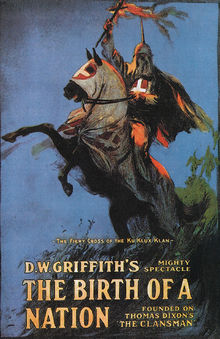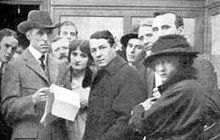The Birth of a Nation
Tampilan
| The Birth of a Nation | |
|---|---|
 Poster rilis teatrikal | |
| Sutradara | D. W. Griffith |
| Produser | D. W. Griffith Harry Aitken[1] |
| Skenario | D. W. Griffith Frank E. Woods |
Berdasarkan | The Clansman karya T. F. Dixon Jr. |
| Pemeran | Lillian Gish Mae Marsh Henry B. Walthall Miriam Cooper Ralph Lewis George Siegmann Walter Long |
| Penata musik | Joseph Carl Breil |
| Sinematografer | G. W. Bitzer |
| Penyunting | D. W. Griffith |
Perusahaan produksi | David W. Griffith Corp. |
| Distributor | Epoch Producing Co. |
Tanggal rilis |
|
| Durasi | 12 rol 133–193 minutes[2] |
| Negara | Amerika Serikat |
| Bahasa | Film bisu Intertitel Inggris |
| Anggaran | >$100,000[3] |
Pendapatan kotor | tidak diketahui; sekitar $50–100 juta[4] |

The Birth of a Nation (awalnya disebut The Clansman) adalah sebuah film drama epik bisu Amerika tahun 1915 yang disutradarai dan diproduksi oleh D. W. Griffith dan dibintangi oleh Lillian Gish. Skenarionya diadaptasi dari novel dan drama The Clansman, keduanya buatan Thomas Dixon Jr. Griffith menulis naskahnya (dengan Frank E. Woods), dan memproduksi film tersebut (dengan Harry Aitken). Film tersebut dirilis pada 8 Februari 1915.
Referensi
[sunting | sunting sumber]- ^ "D. W. Griffith: Hollywood Independent". Cobbles.com. 1917-06-26. Diakses tanggal 2013-07-03.
- ^ "THE BIRTH OF A NATION (U)". Western Import Co. Ltd. British Board of Film Classification. Diakses tanggal August 20, 2013.
- ^ Kesalahan pengutipan: Tag
<ref>tidak sah; tidak ditemukan teks untuk ref bernamaHall & Neale (2010) - ^ Kesalahan pengutipan: Tag
<ref>tidak sah; tidak ditemukan teks untuk ref bernamaMonaco
Daftar pustaka
- Addams, Jane, in Crisis: A Record of Darker Races, X (May 1915), 19, 41, and (June 1915), 88.
- Bogle, Donald. Toms, Coons, Mulattoes, Mammies and Bucks: An Interpretive History of Blacks in American Films (1973).
- Brodie, Fawn M. Thaddeus Stevens, Scourge of the South (New York, 1959), p. 86–93. Corrects the historical record as to Dixon's false representation of Stevens in this film with regard to his racial views and relations with his housekeeper.
- Chalmers, David M. Hooded Americanism: The History of the Ku Klux Klan (New York: 1965), p. 30 *Cook, Raymond Allen. Fire from the Flint: The Amazing Careers of Thomas Dixon (Winston-Salem, N.C., 1968).
- Franklin, John Hope. "Silent Cinema as Historical Mythmaker". In Myth America: A Historical Anthology, Volume II. 1997. Gerster, Patrick, and Cords, Nicholas. (editors.) Brandywine Press, St. James, NY. ISBN 978-1-881089-97-1
- Franklin, John Hope, "Propaganda as History" pp. 10–23 in Race and History: Selected Essays 1938–1988 (Louisiana State University Press, 1989); first published in The Massachusetts Review, 1979. Describes the history of the novel The Clan and this film.
- Franklin, John Hope, Reconstruction After the Civil War (Chicago, 1961), p. 5–7.
- Hickman, Roger. Reel Music: Exploring 100 Years of Film Music (New York: W. W. Norton & Company, 2006).
- Hodapp, Christopher L., and Alice Von Kannon, Conspiracy Theories & Secret Societies For Dummies (Hoboken: Wiley, 2008) p. 235–6.
- Korngold, Ralph, Thaddeus Stevens. A Being Darkly Wise and Rudely Great (New York: 1955) pp. 72–76. corrects Dixon's false characterization of Stevens' racial views and of his dealings with his housekeeper.
- Leab, Daniel J., From Sambo to Superspade (Boston, 1975), p. 23–39.
- New York Times, roundup of reviews of this film, March 7, 1915.
- The New Republica, II (March 20, 1915), 185
- Poole, W. Scott, Monsters in America: Our Historical Obsession with the Hideous and the Haunting (Waco, Texas: Baylor, 2011), 30. ISBN 978-1-60258-314-6
- Simkins, Francis B., "New Viewpoints of Southern Reconstruction", Journal of Southern History, V (February, 1939), pp. 49–61.
- Stokes, Melvyn (2007), D. W. Griffith's The Birth of a Nation: A History of "The Most Controversial Motion Picture of All Time", New York: Oxford University Press, ISBN 0198044364. The latest study of the film's making and subsequent career.
- Williamson, Joel, After Slavery: The Negro in South Carolina During Reconstruction (Chapel Hill, 1965). This book corrects Dixon's false reporting of Reconstruction, as shown in his novel, his play and this film.
Pranala luar
[sunting | sunting sumber]Wikimedia Commons memiliki media mengenai The Birth of a Nation.
- The Birth of a Nation di IMDb (dalam bahasa Inggris)
- The Birth of a Nation: Controversial Classic Gets a Definitive New Restoration Detailed Brenton Film article by Patrick Stanbury on his 2015 restoration, including a history of the film on home video
- The Birth of a Nation at 100 discussion on the BFI's YouTube channel
- The Birth of a Nation tersedia untuk unduhan gratis di Internet Archive
- (Inggris) The Birth of a Nation di TCM Movie Database
- (Inggris) The Birth of a Nation di AllMovie
- The Birth of a Nation di Rotten Tomatoes (dalam bahasa Inggris)
- GMU.edu Diarsipkan 2009-11-23 di Wayback Machine., "Art (and History) by Lightning Flash": The Birth of a Nation and Black Protest
- The Birth of a Nation Diarsipkan 2011-02-24 di Wayback Machine. on Roger Ebert's list of great movies
- The Birth of a Nation on filmsite.org, a web site offering comprehensive summaries of classic films
- Souvenir Guide for The Birth of a Nation, hosted by the Portal to Texas History
- Virtual-History.com, Literature
- NEH's EDSITEment lesson plan The Birth of a Nation, the NACCP, and the Balancing of Rights
- C-SPAN hosted discussions of and aired the film on the occasion of its 100th anniversary:
- Q&A interview with Dick Lehr on his book The Birth of a Nation: How a Legendary Filmmaker and a Crusading Editor Reignited America's Civil War, January 11, 2015
- Introduction to screening and discussions, February 14, 2015
- First part of the film
- Intermission with discussion
- Second part of the film
- Open phone discussion with Hari Jones and Dick Lehr
